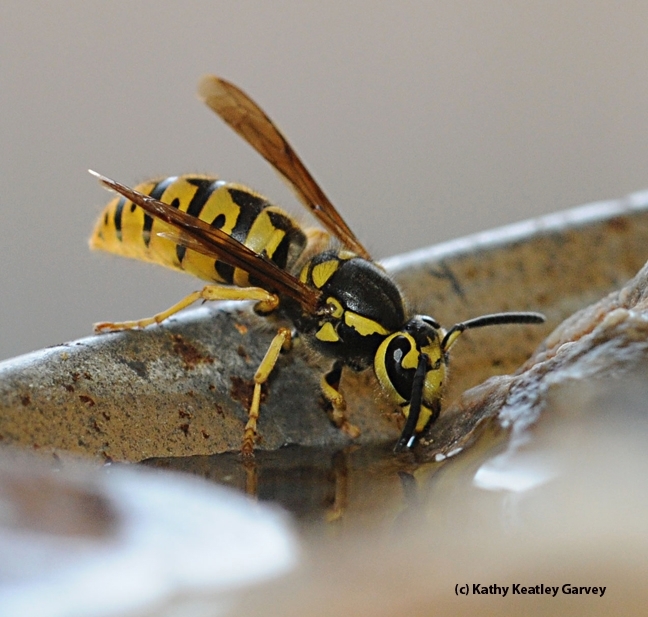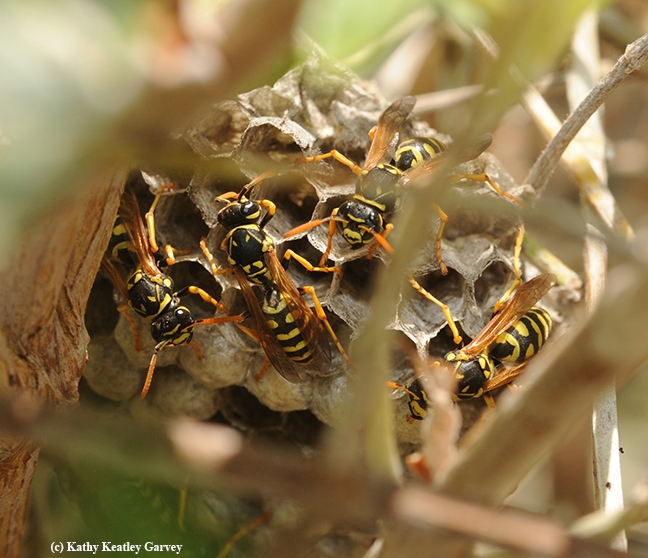
A recent visitor at a camp in the Sierra Nevada mountain range witnessed a large number of wasps and stinging behavior. They crowded around the picnic tables (ah, meat!) and sipped from soda cans (ah, sugar!) She wondered if they were yellowjackets or European paper wasps.
From the description and behavior: yellowjackets.
"European paper wasps (Polistes dominula) are not scavengers," says Lynn Kimsey, director of the Bohart Museum of Entomology and a professor of entomology at UC Davis. "They only take live insects, particularly caterpillars. Western yellowjackets, Vespula pensylvanica, are serious scavengers and are major pests in the Sierra and elsewhere. Their colonies are annual, which means that fertilized new queens must overwinter in protected places until it warms enough in the spring to begin new colonies. As the new colonies are building they need a lot of protein for their babies. The larger the colonies get the more they need."
"If many new queens survived the winter because temperatures were warmer and drier than usual then there will be many colonies to deal with, all competing for food. By late in the season the colonies go more into maintenance mode, needing a lot of sugar. They aren't feeding many babies, which need protein, and the large number of adults need sugar for fuel."
"At this point, control is largely useless," Kimsey says. "Control measures need to be started in the mid to late spring and the best control method is the use of baited traps, not spraying. Also when colonies are found they need to be removed--this needs to be done at night. These wasps nest in cavities, mostly in the ground but also in attics, wall voids and hollow trees if available. The large number of stings suggests that a colony or colonies were nearby."
"So at this point it's best to hope for a long cold, wet winter," Kimsey says.
The UC Statewide Integrated Pest Management Program (UC IPM) provides a wealth of information on Western yellowjackets and paper wasps on its PestNote: "In Western states there are two distinct types of social wasps—yellowjackets and paper wasps. Yellowjackets are by far the most troublesome group, especially ground- and cavity-nesting ones such as the western yellowjacket, which tend to defend their nests vigorously when disturbed. Defensive behavior increases as the season progresses and colony populations become larger while food becomes scarcer. In fall, foraging yellowjackets are primarily scavengers, and they start to show up at picnics and barbecues, around garbage cans, at dishes of dog or cat food placed outside, and where ripe or overripe fruit are accessible. At certain times and places, the number of scavenger wasps can be quite large."
"Paper wasps are much less defensive and rarely sting humans," according the to the UC IPM PestNote. "They tend to shy away from human activity except when their nests are located near doors, windows, or other high-traffic areas."
The UC IPM authors point out that "Typically, previously mated, overwintering yellowjacket and paper wasp queens begin their nests in spring when the weather becomes warm. The queen emerges in late winter to early spring to feed and start a new nest. From spring to midsummer, nests are in the growth phase, and larvae require large amounts of protein. Workers forage mainly for protein at this time—usually other insects—and for some sugars. By late summer, however, the colonies grow more slowly or cease growth and require large amounts of sugar to maintain the queen and workers; foraging wasps are particularly interested in sweet things at this time. Normally, yellowjacket and paper wasp colonies live only one season. In very mild winters or in coastal California south of San Francisco, however, some yellowjacket colonies survive for several years and become quite large."
UC IPM has posted an informative YouTube video, "Distinguishing Between Yellowjackets, Wasps, and Look Alikes." Look closely and you can see that those European paper wasps have distinctive orange antennae. Yellowjacket antennae are black.
Or, to put it another way: Yellowjacket antennae are black, like the Oakland Raiders' logo, and European paper wasp antennae are orange, like the logo of the San Francisco Giants.
Attached Images:

A Western yellowjacket, Vespula pensylvanica, sipping water. Note the black antennae. (Photo by Kathy Keatley Garvey)

A European paper wasp, Polistes dominula, soaking up sun. Note the orange antennae.(Photo by Kathy Keatley Garvey)

This is a European paper wasp nest tucked inside a shrub. Yellowjacket nests are often in abandoned rodent nests. (Photo by Kathy Keatley Garvey)